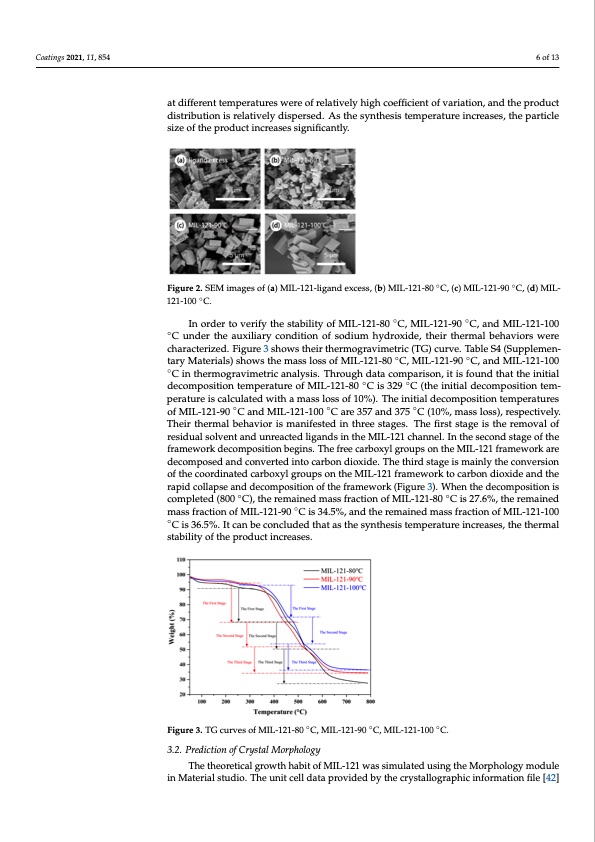
PDF Publication Title:
Text from PDF Page: 006
Coatings 2021, 11, 854 6 of 13 at different temperatures were of relatively high coefficient of variation, and the product distribution is relatively dispersed. As the synthesis temperature increases, the particle size of the product increases significantly. Figure 2. SEM images of (a) MIL-121-ligand excess, (b) MIL-121-80 ◦C, (c) MIL-121-90 ◦C, (d) MIL- 121-100 ◦C. In order to verify the stability of MIL-121-80 ◦C, MIL-121-90 ◦C, and MIL-121-100 ◦C under the auxiliary condition of sodium hydroxide, their thermal behaviors were characterized. Figure 3 shows their thermogravimetric (TG) curve. Table S4 (Supplemen- tary Materials) shows the mass loss of MIL-121-80 ◦C, MIL-121-90 ◦C, and MIL-121-100 ◦C in thermogravimetric analysis. Through data comparison, it is found that the initial decomposition temperature of MIL-121-80 ◦C is 329 ◦C (the initial decomposition tem- perature is calculated with a mass loss of 10%). The initial decomposition temperatures of MIL-121-90 ◦C and MIL-121-100 ◦C are 357 and 375 ◦C (10%, mass loss), respectively. Their thermal behavior is manifested in three stages. The first stage is the removal of residual solvent and unreacted ligands in the MIL-121 channel. In the second stage of the framework decomposition begins. The free carboxyl groups on the MIL-121 framework are decomposed and converted into carbon dioxide. The third stage is mainly the conversion of the coordinated carboxyl groups on the MIL-121 framework to carbon dioxide and the rapid collapse and decomposition of the framework (Figure 3). When the decomposition is completed (800 ◦C), the remained mass fraction of MIL-121-80 ◦C is 27.6%, the remained mass fraction of MIL-121-90 ◦C is 34.5%, and the remained mass fraction of MIL-121-100 ◦C is 36.5%. It can be concluded that as the synthesis temperature increases, the thermal stability of the product increases. Figure 3. TG curves of MIL-121-80 ◦C, MIL-121-90 ◦C, MIL-121-100 ◦C. 3.2. Prediction of Crystal Morphology The theoretical growth habit of MIL-121 was simulated using the Morphology module in Material studio. The unit cell data provided by the crystallographic information file [42]PDF Image | Small Particles for Lithium Adsorption from Brine

PDF Search Title:
Small Particles for Lithium Adsorption from BrineOriginal File Name Searched:
coatings-11-00854-v2.pdfDIY PDF Search: Google It | Yahoo | Bing
Product and Development Focus for Infinity Turbine
ORC Waste Heat Turbine and ORC System Build Plans: All turbine plans are $10,000 each. This allows you to build a system and then consider licensing for production after you have completed and tested a unit.Redox Flow Battery Technology: With the advent of the new USA tax credits for producing and selling batteries ($35/kW) we are focussing on a simple flow battery using shipping containers as the modular electrolyte storage units with tax credits up to $140,000 per system. Our main focus is on the salt battery. This battery can be used for both thermal and electrical storage applications. We call it the Cogeneration Battery or Cogen Battery. One project is converting salt (brine) based water conditioners to simultaneously produce power. In addition, there are many opportunities to extract Lithium from brine (salt lakes, groundwater, and producer water).Salt water or brine are huge sources for lithium. Most of the worlds lithium is acquired from a brine source. It's even in seawater in a low concentration. Brine is also a byproduct of huge powerplants, which can now use that as an electrolyte and a huge flow battery (which allows storage at the source).We welcome any business and equipment inquiries, as well as licensing our turbines for manufacturing.| CONTACT TEL: 608-238-6001 Email: greg@infinityturbine.com | RSS | AMP |